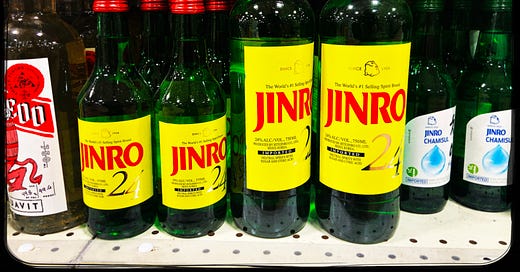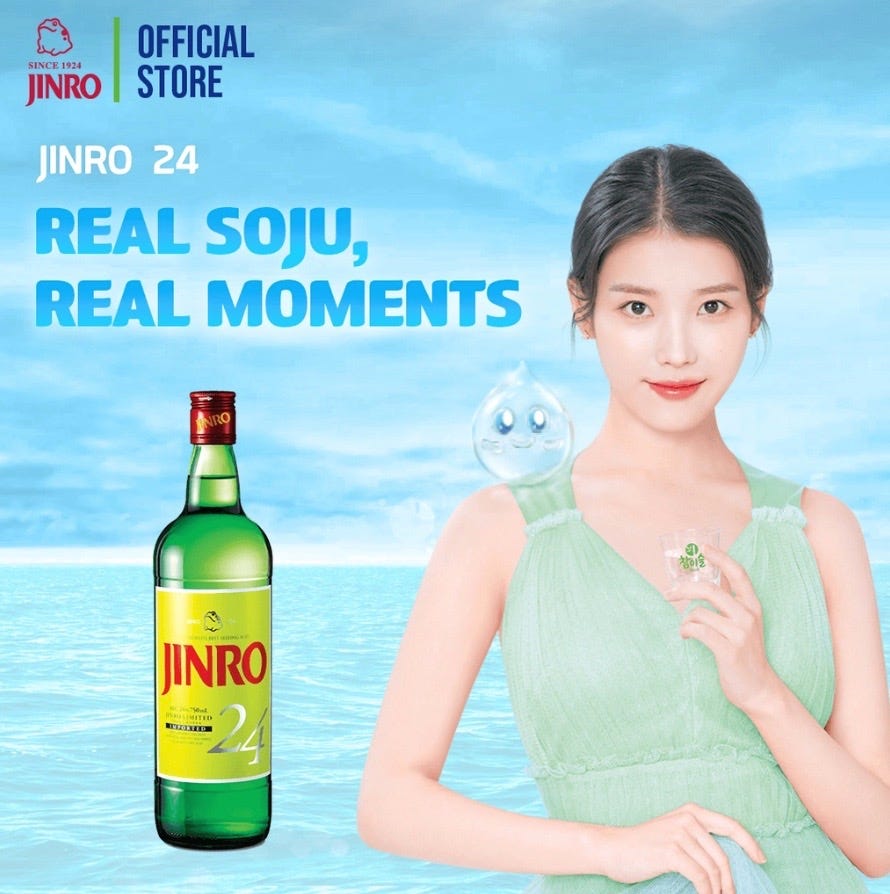Pictured here, fittingly and literally located on the bottom shelf.
South Korea is one of the hardest drinking cultures on the planet. Last year, the average Korean adult drank 83 bottles of beer and 53 bottles of soju.
That’s a lot of hooch.
If you indulge responsibly, you know that it’s fairly easy to put down a few bottles of beer or glasses of wine on a Saturday evening, but soju packs a significantly larger punch. The average alcohol by volume (ABV) of beer hovers around 5 percent and wine 12 percent, whereas the average ABV of soju is somewhere around 20 percent. Puts those Korean numbers in context.
So what, exactly, is soju?
First, it’s the national spirit of Korea. Traditionally it was distilled from rice. However, in the mid-1960s, Korea experienced a rice shortage and the government banned its use in soju – a ban that lasted more than 30 years. As an alternative, distillers turned to various types of grains and starches, including wheat, barley, sorghum, tapioca and sweet potato.
Today—although rice is now allowed in its production—distillers often include multiple grains and/or starches. The resulting spirit is clear and—for the accessible, inexpensive stuff—usually available in a ubiquitous green bottle. This container choice was originally meant to promote one brand’s “clean and mild taste” and it was such a massive hit that seven soju companies agreed to use identical bottles across their respective brands to make bottle recycling more efficient.
Now that’s what I call GOING GREEN. Am I right, people? Ahem.
This week, we’re going with an inexpensive, mass-produced green bottle soju: Jinro 24. Jinro is not only the most popular brand of soju in Korea – it’s the best-selling spirit in the world.
Lucky for me, that means it’s readily available at many liquor stores in the U.S., so I didn’t have to go far to track it down. This one was literally located on the bottom shelf of my local Binny’s and was extraordinarily affordable at a mere $6.
Jinro 24 comes in at—you guessed it—24 percent ABV. It contains neutral spirit as well as sugar and citric acid and is distilled from “choice grains and spring water.” Those grains are specifically rice, barley and tapioca, if you’re wondering.
I tasted this chilled which is the preferred way to drink it in Asia, where it’s usually served neat or consumed along with beer. Which, if you’ve ever watched a Korean drama, you probably know already. Can’t miss those super-recognizable distinctive green bottles!
This woman’s drinking Jinro 24 straight up from a shot glass, as is tradition.
THE TASTING
For the initial tasting, I’m consuming this chilled from a standard shot glass. It pours crystal clear and thin – no legs when I swirl it around the (admittedly small) glass.
On the nose, there’s a faint ethanol aroma, reminiscent of isopropyl alcohol. The first sip tastes a bit like cheap sake mixed with a neutral grain spirit, with little distinctive flavor to pick out. On the finish, there’s some residual sweetness and a hint of very subtle floral notes that don’t stick around long. There’s no ethanol burn that might accompany a higher-proof spirit like vodka.
I’m a little taken aback by the taste, or lack thereof. With the addition of sugar and citric acid, I expected something a little more distinct, or perhaps with a hint of lemon-lime soda. But nada.
Granted, I initially tried this chilled, and that does impact the aromas and flavors one can pick up. Out of a profound sense of FAIRNESS AND JUSTICE, I let a small sample warm up to room temperature and tried it again but didn’t find any significant differences. If anything, there was maybe a little more sweetness on the finish.
This one seems to be distilled to be neutral and inoffensive. And that’s OK! I could see this being fun and dangerously easy to drink alongside beers on a night out with pals, which seems to be the most common way it’s consumed in its native country.
HOW SHOULD YOU DRINK IT?
…Shots? OK, we can do better than that.
Whenever I try a new spirit from a specific geography, I like to research local cocktails to see how it’s used back home. And one specific cocktail kept popping up here: Yogurt Soju. It looks like the traditional way to make this is with Yakult, a Japanese probiotic yogurt drink. But I didn’t have Yakult, so I improvised.
Here’s how I made it:
Mixed Berry Yogurt Soju
3 oz Jinro 24 soju
3 oz Mixed Berry Kefir (I used Lifeway Kefir Mixed Berry 1%)
3 oz Sprite
Add the soju and the kefir to a shaker tin. Add ice. Shake until cold. Crack open the shaker and pour in the Sprite. Mix with a barspoon. Strain into a rocks glass.
It’s not every day I drink cocktails made with yogurt, but this is tasty and downright refreshing. I was worried about the thickness of the kefir in this cocktail, but it’s thinned out thanks to the dilution of the ice and the other ingredients.
I had reservations about mixing yogurt and soda, but to my surprise everything here is balanced and plays its role. The tangy, fruity kefir is there, of course, and the sweet and sour lemon-lime soda complements that flavor while providing a bit of effervescence and brightness. But the soju isn’t lost, reminding you of its presence on the finish.
This would be a terrific cocktail to serve with spicy food. Korean BBQ is the obvious choice here. But drinking this with Indian food and subbing a fruit lassi for the kefir could be a winner.
Jinro 24: Cheap, drinkable and extremely popular, no doubt in large part due to those first two characteristics. Next time I’m with a group of friends around a charcoal grill gorging on bulgogi, first bottle of soju is on me.





